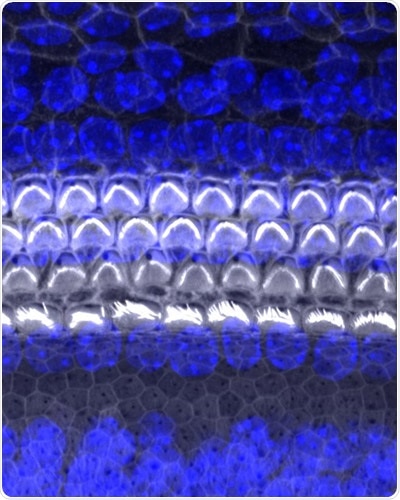Scientists from the University of Maryland School of Medicine (UMSOM) have performed a study that has successfully established the role played by a crucial protein in the development of hair cells.

Hair cells in the inner ear. Image Credit: University of Maryland School of Medicine.
Such hair cells are important for hearing. A few of these hair cells amplify sounds that enter the ear, while others convert sound waves into electrical signals that reach the brain.
Ronna Hertzano, MD, PhD, an Associate Professor in the Department of Otorhinolaryngology Head and Neck Surgery at UMSOM together with Maggie Matern, PhD, a postdoctoral fellow from Stanford University, showed that the protein, known as GFI1, may be important for ascertaining whether an embryonic hair cell develops into a functional adult hair cell or turns out to be a different cell that works more like a neuron or nerve cell.
Published in the Development journal, the study was performed by physician-scientists and investigators from the UMSOM Department of Otorhinolaryngology Head and Neck Surgery and the UMSOM Institute for Genome Sciences (IGS), in association with scientists from the Sackler School of Medicine at Tel Aviv University in Israel.
Hearing depends on the correct functioning of specialized cells inside the inner ear known as hair cells. When the hair cells are impaired by environmental stresses, such as loud noise, or do not develop properly, it leads to a loss of hearing function.
In the United States alone, the prevalence of hearing loss increases by two-fold with every 10-year increase in age, impacting around 50% of all adults in their 70s, and around 80% of those aged above 85. Scientists have been focusing on explaining the developmental stages that result in a functional hair cell to possibly create new hair cells when old ones are impaired.
In the new study, Dr Hertzano and her group used advanced approaches to analyze the expression of genes in the hair cells of genetically altered newborn mice that did not synthesize the GFI1 protein.
The team showed that the absence of this crucial protein inhibited the embryonic hair cells from developing into fully functional adult cells. As a matter of fact, the genes expressed by these embryonic hair cells indicated that they would probably develop into neuron-like cells.
Our findings explain why GFI1 is critical to enable embryonic cells to progress into functioning adult hair cells. These data also explain the importance of GFI1 in experimental protocols to regenerate hair cells from stem cells. These regenerative methods have the potential of being used for patients who have experienced hearing loss due to age or environmental factors like exposure to loud noise.”
Ronna Hertzano, MD, PhD, Associate Professor, Department of Otorhinolaryngology Head and Neck Surgery, University of Maryland School of Medicine
While completing her MD, PhD at Tel Aviv University, Dr Hertzano initially became interested in the GFI1 protein. As part of her thesis, Dr Hertzano found that the hearing loss resulting from mutations in another type of protein known as POU4F3 seemed to mostly result from the loss of the GFI1 protein in the hair cells.
Since that time, Dr Hertzano has been conducting studies to identify the function of various proteins, including GFI1, in hearing. Other research teams in this domain are currently testing these proteins to establish whether they can be applied as a “cocktail” to regenerate lost hair cells and thus restore hearing.
Hearing research has been going through a Renaissance period, not only from advances in genomics and methodology, but also thanks to its uniquely collaborative nature among researchers.”
Ronna Hertzano, MD, PhD, Associate Professor, Department of Otorhinolaryngology Head and Neck Surgery, University of Maryland School of Medicine
The latest study was financially supported by the National Institute on Deafness and Other Communication Disorders (NIDCD) which is part of the National Institutes of Health (NIH). It was also financially supported by the Binational Scientific Foundation (BSF).
This is an exciting new finding that underscores the importance of basic research to lay the foundation for future clinical innovations. Identifying the complex pathways that lead to normal hearing could prove to be the key for reversing hearing loss in millions of Americans.”
E. Albert Reece, MD, PhD, MBA, Executive Vice President for Medical Affairs, University of Maryland, Baltimore,
Reece is also the John Z. and Akiko K. Bowers Distinguished Professor and Dean from the University of Maryland School of Medicine.
Source:
Journal reference:
Matern, M. S., et al. (2020) GFI1 functions to repress neuronal gene expression in the developing inner ear hair cells. Development. doi.org/10.1242/dev.186015.